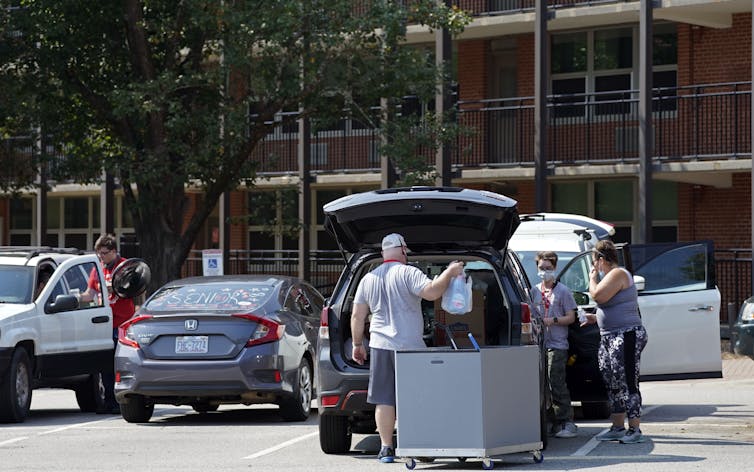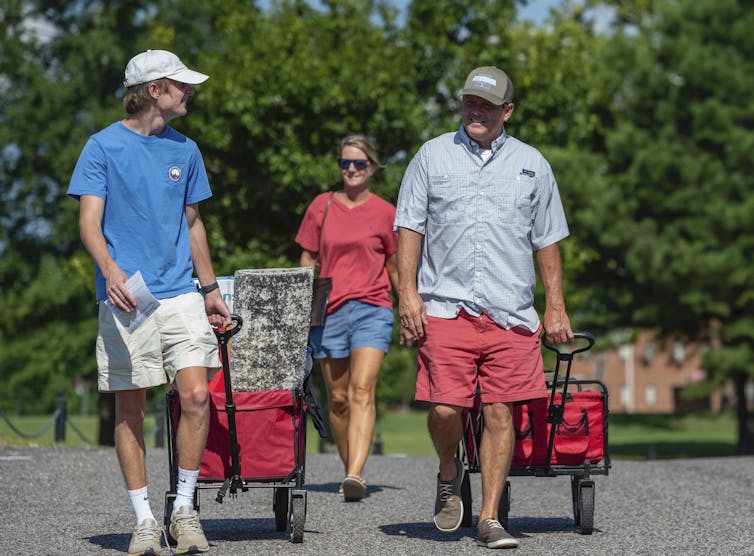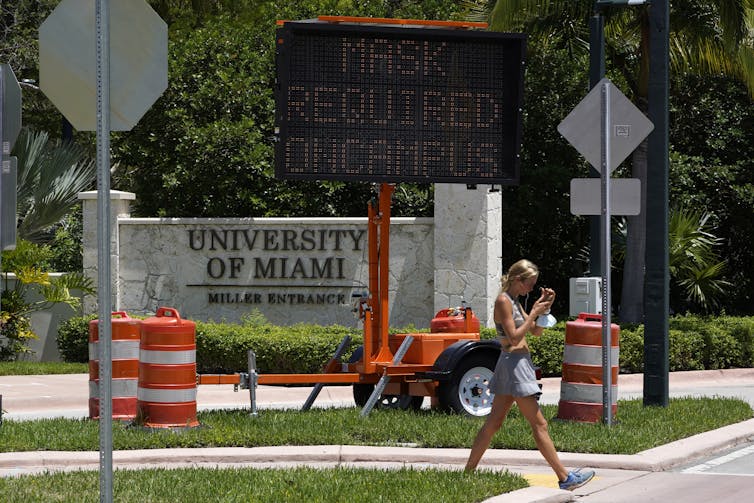
Campus outbreaks of COVID-19 were almost guaranteed

Ryan Malosh, University of Michigan and Nina Masters, University of Michigan Medical School
Scientists have learned a few things over the past six months as the COVID-19 pandemic has continued. We’ve learned that the virus that causes COVID-19 transmits particularly well when a group of people are together in a small, poorly ventilated area. We’ve learned that young people are just as susceptible as older people to infection. We’ve learned that if there is widespread community transmission, the virus will find its way to the very places we don’t want it go.
So, it’s not surprising to us, researchers who study diseases that can be prevented by vaccines, that with schools and colleges reopening, the virus is spreading.
These are places designed around the idea of bringing lots of people to one place. Many of them bring people together from all over the world. They are perfect places for disease to spread.

How we got here
Back in March, colleges and universities closed down like everything else except essential businesses. They sent students home. There was a rough transition to online instruction. Students weren’t happy, faculty weren’t happy. And so, they started to come up with plans on how to reopen for in-person instruction for the fall semester.
Many places installed plexi-glass barriers in classrooms, considered mask mandates and worked out physical distancing in lecture halls. Most people realized that professors who taught large classes should plan for remote learning.
University administrators and public health experts started making these plans in the spring. Back then, we scientists and public health researchers all operated under the assumption that community spread would be under some sort of control by fall. We all thought that the country would increase testing capacity, and we have. Then, once new cases dropped to a low level, we could institute contact tracing, the way other countries had.
But that part hasn’t happened. And so now these same colleges and universities are facing huge increases in cases, including at the University of North Carolina, Notre Dame and the University of Alabama. Many universities that have opted to return to in-person classes are also having a surge in cases. These outbreaks will inevitably spread to the wider communities in which the campuses are located.
It seems that for many of these institutions, the priority was on financial concerns, which involved a return to a normal fall semester to the greatest extent possible. They then developed plans that they thought would make this possible. Faculty at many institutions and at least one ethics committee have argued that the priority should have been the safety of students, faculty and the surrounding communities.
While schools across the country have different priorities, enrollments, campus size, and student demographics, many schools share one thing in common: making no real contingency plans around reopening amid COVID-19, other than going remote if governors mandated it.
The schools that did spend the summer figuring out how to deliver high quality education remotely, or how to safely provide housing and access to services for the most vulnerable students, are less likely to have their fall semester disrupted. However, the College Crisis Initiative’s data dashboard found that only 7% of 1,442 four-year schools surveyed were planning on a fully online fall semester.

The challenge ahead
And so, the inevitable has come to pass. Now, many college campuses will struggle to control their outbreaks, because there are a lot of unique challenges inherent to COVID-19 in this population.
Colleges are not nursing homes or prisons. Some are trying to limit contact with the broader community.
But in general, students are not kept under lock and key. They have visitors from other schools. They go back and forth to their parents’ homes. And, yes, they go to parties. To us, blaming students for wanting a normal-ish college experience when the schools themselves have set the tone for trying hard to return to normal isn’t fair.
It’s also true that not all of the contact students have is as irresponsible as some have suggested. Many students hold jobs in the communities that surround the school. And most of these jobs aren’t typically the work-from-home type of job. In our undergraduate careers we both worked at jobs that had high contact rates with the community. And often, when your job is waiting tables at a local pizza place or manning a library desk, most of your colleagues are students as well. All of these factors will make contact tracing very hard.
Public health experts also expect a relatively high proportion of college-aged students to be either completely asymptomatic or to only have very mild symptoms. Without universal testing, these students won’t know they’re sick. They may not isolate if they have mild symptoms. But they will still be able to spread the virus to others. Symptom and temperature screenings may not recognize these individuals as those who need to stay away from campus buildings.
A different kind of campus test
Which brings us to testing. Some places are doing universal testing of students, multiple times per week. But, given the state of testing in the U.S., that is not a realistic possibility for most schools.
Let’s look at our university as an example. The University of Michigan has an undergraduate population of 30,000 students. Let’s assume that two-thirds of them came back to campus. That means 40,000 tests per week just for University of Michigan undergraduate students. Right now the entire state of Michigan is doing a little more than 200,000 diagnostic tests per week. Some schools have developed their own tests to handle this huge increase in capacity. But many university labs are involved in testing for large health systems and the rest of the state too. In these places it becomes very difficult for 1 in 5 tests available in an entire state to be dedicated to the students at a single university.
A scale-up of rapid, at-home antigen tests could be one approach to make testing on this scale feasible. These types of tests have the advantage of detecting highly infectious individuals – making them a good screening tool – but many are not approved by the Food and Drug Administration because they aren’t as sensitive as the standard PCR-based diagnostic test.
[The Conversation’s science, health and technology editors pick their favorite stories. Weekly on Wednesdays.]
If transmission on campus continues to happen mostly outside of the classroom, simply going remote will not solve the problem. Keeping students on campus will be risky. Many students will be attempting to navigate social distancing guidelines without a traditional social support network.
As much as possible, we believe students need to be able to safely return to their homes. But this can’t be done haphazardly. Bringing them to campus was a predictable risk – so is sending them home. As colleges inevitably move back to online instruction, plans must be put in place to minimize the risk of seeding epidemics. Dismissing all students, some of whom are infectious, back to their home communities risks spreading the virus further across the country, a bad outcome for all.
The unique epidemiology of COVID-19 in young adults, along with the contact patterns on college campuses and the inability to effectively screen through symptom reports or diagnostic testing, have left college campuses with few options for safely operating with in-person classes. We know that few wanted an all-remote fall semester, but it’s becoming clear that was probably our best bet.![]()
Ryan Malosh, Assistant Research Scientist, University of Michigan and Nina Masters, Doctoral candidate, epidemiology, University of Michigan Medical School
This article is republished from The Conversation under a Creative Commons license. Read the original article.
















